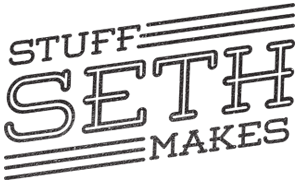I need to start by saying I’ve never done this before, so if you have any pointers in case I ever do one of these again, feel free to leave them in the comments or shoot me an email.
Aymerick Modern in San Marcos, California has got to have the largest inventory of mid century modern furniture I’ve ever seen. If you’re looking for great pieces for your home, whether it’s a desk, a chair, a table….whatever…definitely check with Aymerick. He really knows his stuff! Recently he showed me some drawers to a piece he had acquired, but the drawers with the piece had been repaired/modified with a horizontal strip of veneer that shouldn’t have been there. He told me he had some extra teak veneer and wondered if I could somehow update the drawer faces with the new veneer. Having never really worked with veneer before, I was hesitant because I didn’t want to further damage the antique. But looking at the situation and thinking it through a bit, I decided to go for it. Here’s a picture of the drawers and you can see the horizontal strips that were added. Why on only two of the drawers and not all three? Who knows. Fortunately Aymerick was able to remove the handles. I think it would’ve been more tricky if this had to be done with the handles in place.
.jpg)
Here you can see the drawers after I started sanding down the finish:
.jpg)
.jpg)
And of course a picture of the roll of the teak veneer:
.jpg)
As I sanded, I noticed some of the edges of the original veneer cracking and lifting up and then a larger chunk lifted up when it caught the sandpaper and at first I panicked but then remembered I was repairing it anyway, so who cares, haha! I started lifting up more edges and before I knew it, I had basically scraped off all the original veneer so I ended up just going for it and taking off all the original veneer. You can even see the old veneer tape:
.jpg)
When I got to the horizontal strips and removed those, I found a bit of a mess. It seems somebody had maybe chipped away a shallow 1-inch wide recess with a chisel or something but as you can see it wasn’t done with the steadiest of hands….or they were cross-eyed….or drunk…or both. Either way, I needed to think of something so the new veneer would lay flat across the surface.
.jpg)
.jpg)
The solution I decided to go with was to set up my Bosch router at the router table with a 3/4″ straight bit and made a couple passes to clean up the original recess and make it even and flat, even though it meant removing a tiny bit more material:
.jpg)
And as you can see I’m left with a nice, even, clean recess:
.jpg)
.jpg)
.jpg)
Next I grabbed a piece of soft maple I had in the scrap bin and ripped down a couple strips that were slightly larger than the recess. I put down some Titebond glue and and clamped the strips into the recesses:
.jpg)
.jpg)
.jpg)
.jpg) My next step was to trim off the excess from the maple strips, on the ends, edges and face. I had to make some shims so I could keep the drawer leveled as I ran it across the router table, and I used Fastcap speedtape double-sided tape to secure the shims to the drawer bottom so the shim setup would slide with the drawer.
My next step was to trim off the excess from the maple strips, on the ends, edges and face. I had to make some shims so I could keep the drawer leveled as I ran it across the router table, and I used Fastcap speedtape double-sided tape to secure the shims to the drawer bottom so the shim setup would slide with the drawer.
To do the trimming, I used one of my Mega Flush Trim bits from Infinity Tools. This was this router bit’s maiden voyage….fresh out of the package. I expected the edges and ends to trim up nicely but wondered how it would perform on the face. The answer? Perfectly.
.jpg)
.jpg)
.jpg)
.jpg)
The new veneer had a perfect seam down the middle and of course that needed to go straight down the center of the drawer faces, so I marked the center of the drawers so I’d have a reference line. Then I used the reference lines and the seam on the veneer to trace the drawer faces, then I cut out the pieces:
.jpg)
.jpg)
.jpg)
To glue the veneer I applied Titebond Original to the surface and spread it around evenly:
.jpg)
To clamp the veneer to the drawer face I made some clamping cauls out of some scrap wood. You’ll notice the cauls have a slight curve. This is so that as I tighten the clamps on the ends, the pressure is still distributed evenly across the whole long surface. Of course I used other clamps too because you know what they say, “You can never have too many clamps!”
.jpg)
.jpg)
The clamping setup was a success! Next would be to trim the excess veneer off the edges and wouldn’t you know…I forgot to take pics of this step! I tried a couple techniques. I tried carefully trimming with a new razor blade, following the backside edge of the drawer face. A few light scoring passes got through the veneer nicely. I also tried trimming the excess veneer over at the router table with a smaller Freud flush trim bit. Both trimming techniques pretty much gave me the same results, however I got one tiny chip along the way:
.jpg)
The chip was actually a little smaller than what you see in the above picture, but I wanted to try and fix it so I enlarged chip ever so slightly and tried to square off the end. Then using a scrap of the veneer I cut out a little teeny tiny sliver that would act as a veneer inlay, and I applied a very small amount of glue to the cut away area, spreading it evenly, and put a clamp on it so it would stay pressed down tight:
.jpg)
.jpg)
After the glue dried I trimmed the excess off the tiny piece of inlay veneer and lightly sanded over it, hoping for the best, and:
.jpg)
So all in all I think this was a pretty successful repair! Again, this is the first time I’ve ever done a project like this and I was just using my best judgement as far as techniques go. The end result is a nicely lined up veneer (the veneer was already bookmatched). I love how the teak woodgrain flows continuously straight up and down the drawer faces, almost as if I applied one long piece of veneer first, and then cut the three drawers apart, but I did them individually. Not bad for a veneer rookie, haha!
.jpg)
Aymerick will proceed to color match and finish these out, and I believe he already has a buyer for this particular piece of furniture. When I stopped by his place to talk about another project, he had about 20 other pieces wrapped and packed that were shipping out to customers. So again, if you’re looking for a piece of mid century modern furniture to set off your space, check out what Aymerick Modern has to offer. Who knows, maybe you’ll get a piece that I helped with too, haha!
Thanks for stopping by my blog. I’m always learning so if you have any recommendations or other pointers as far as veneer repairs are concerned, let me know!







